This article is from the Australian Property Journal archive
THE Opposition’s Budget Reply has received a mixed response from the property industry, with calls to remove recent industrial relation reforms and boosting construction skills welcomed, while calls to cut international students have largely fallen flat.
The Student Accommodation Council has rejected the Opposition’s policy to cut back on international students, calling attention to their recent report which showed the cohort make up just 4% of the rental market Australia wide.
Additionally, the council noted students significantly prefer to live in student accommodation and apartments within CBDs, rather than in the suburban family homes that are most in demand by the average Australian renter.
“International students have been unfairly blamed for the rental crisis, when long term structural issues in Australia’s housing market are the real cause for rental pressures. We need to look at the broad spectrum of issues driving up rent and reducing the supply of homes, rather than blaming a single cohort,” said Torie Brown, executive director at the Student Accommodation Council.
“If we remove international students from our CBDs we will have a lot of empty student accommodation buildings and a lot of struggling small businesses, but we won’t be adding a large amount of rental homes back into the market for Australian families.”
“The Coalition’s plan to slash student numbers will tank the international education sector – which is worth $49 billion annually and is Australia’s largest service export – for the sake of four per cent of the rental market.”
The council also highlighted that international students are also a major supporter of CBD economies, which are still struggling with the lukewarm return of workers to offices.
“International students are also temporary migrants. They come over, they study, and the vast majority of them go home. They are after the flexible short-term rental options offered by student accommodation, they are not trying to buy homes in the suburbs,” added Brown.
The Property Council of Australia has also cautioned against “arbitrary caps” on international students, while also noting the Coalition’s plan for a two-year ban on foreign investors and temporary residents purchasing existing homes in Australia will not support new housing supply.
“The only way to properly address the nation’s housing deficit is to build more homes using domestic and global investment and to do this we need to improve investment settings, incentivise housing approvals and fix broken state planning systems, and boost high quality housing options including retirement living, purpose-built student accommodation and build-to-rent housing,” said Mike Zorbas, chief executive at the Property Council.
The Property Council has welcomed plans to boost construction skills in Australia’s immigration mix amidst the nation’s significant labour deficit.
At the same time Zorbas warned against focusing on numbers rather than skills needed across key industries.
“The key to balancing migration policy is to focus on skills rather than overall numbers,” added Zorbas.
“We have consistently supported a targeted reduction to overall migration numbers from the post-pandemic peak, but the key to addressing housing affordability remains increasing the total number of new homes we build. We need faster zoning, approvals and last mile infrastructure but most of all we need the people who will build our cities.”
HIA WA is also emphasising the importance of skilled migration levels and supporting the state government’s targeted to program to support WA employers who were interested in attracting migrants with construction skills, which was launched in response to the Budget.
“Our industry has been built on a foundation of migrants moving to Australia looking for a new life and this program continues the tradition,” said Michael McGowan, executive director at HIA WA.
“Our housing challenges aren’t going away anytime soon, so investing in a steady flow of skilled migrants while also funding 450 apprentices into the residential building industry is a responsible long-term approach. Of course we would like these people here sooner, but for those navigating it for the first time there are some unknowns that need to be worked through.”
Master Builders Australia has also applauded the call for a migration policy that enhances the viability of construction.
“The industry needs half a million new workers over the next three to five years which we cannot fill domestically alone – skilled migration represents a vital piece of the puzzle. Both major parties have this week committed to ensuring Australia is an attractive destination for skilled migrant tradies,” said Denita Wawn, CEO at Master Builders Australia.
“With considerable numbers of older workers retiring from the construction industry each week, the pressure to replace their decades of experience and upskilling is considerable. We welcome incentives to encourage older workers back into the workforce without reducing pension payments.”
The industry body has also welcomed plans to walk back on industrial relation reforms to provide more certainty for businesses.
“The Government’s recent industrial relations legislation ultimately make home building more expensive and blow out supporting infrastructure projects,” added Wawn.
“Recent modelling found under a best-case scenario, new industrial relations laws will see at least 15,000 fewer homes and almost 8,000 fewer jobs and cost the economy over $113 billion over the next five years.”
“Master Builders welcomes the Opposition’s decision to extend and expand the instant asset write-off for small business to $30,000, $10,000 more than the Government’s policy but more support is needed.”




